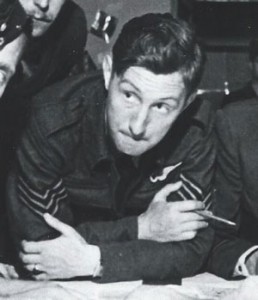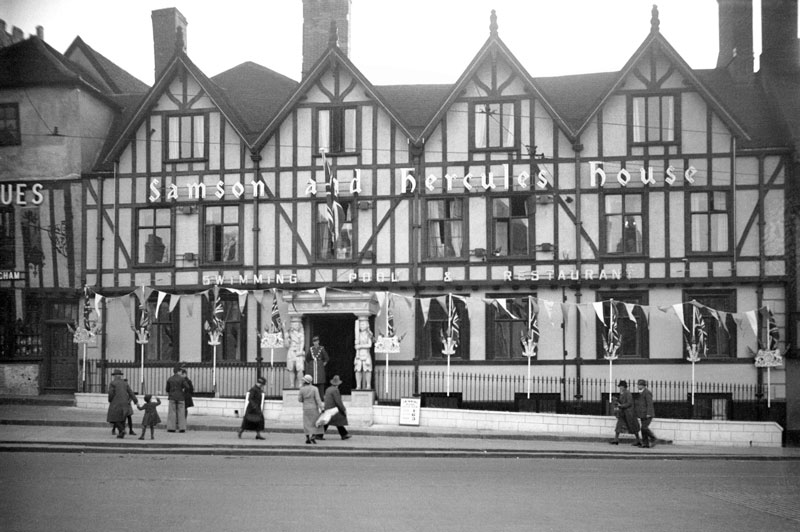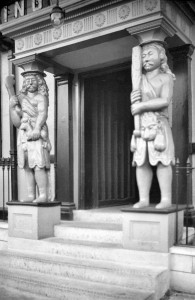
And now to the crew that I would judge the most colourful of the raid on Rotterdam, if not in the entire annals of 2 Group. Some people go through life hardly causing a ripple on the water; others, such as John Wotherspoon and his crew, leave behind them no less than a tidal wave.
The Wotherspoon crew’s fearlessness and unquenchable thirst for danger has already been stated in Mast High Over Rotterdam; but how were they judged by their colleagues on 21 Squadron? Assessments varied so wildly that I wondered if an element of confusion had crept in. Then I remembered the subjectiveness reflected in an Officer’s Annual Confidential Report, and how a person’s career can be severely set back, if not sunk without trace, if he does not speak the same language as his current CO. Obviously John Wotherspoon and crew impressed some, but left others with feelings of disdain. It is not for me to say where the truth lies: I did not know them. All I can do is record the sentiments expressed and let readers make their own decisions.
Robbie Robertson, the lead observer on the Rotterdam raid, is in no doubt whatsoever where he places the crew. ‘They were just plumb stupid’, Robbie told me. ‘Both Wotherspoon and his navigator. They did some very silly things. Well, I did at times, but it stuck in my mind that they were flying the wrong way round on one occasion. They went off once to attack Flushing [Vlissingen, Netherlands], or thereabouts, and were hit by flak.

In a flustered state, they flew north for thirty minutes, then went back over the same place again, completely lost. They then turned west and flew up the Thames Estuary. Still lost, and short of fuel, they crash-landed on the south bank. Thinking that they’d landed in Germany or France or somewhere, they burned their books etc and gave themselves up. They didn’t know where they were: they got into a terrible state. And they were picked up by a Thames Police patrol. They were rather amazed!’
Robbie considered John Wotherspoon a poor pilot, and was detailed to investigate the navigational problems of the crew after this incident. The occurrence is well camouflaged in the 21 Squadron ORB which, considering the quality of the document during this period, is hardly surprising. On the other hand, embarrassing incidents are not welcome in a squadron diary…
Could the entry in the ORB for 22nd July 1941 be a strong contender for the award of cover-up of the year? On this date, Wotherspoon and crew, operating from Manston, were detailed for a daylight attack on shipping near Gravelines (15 miles southwest of Dunkirk). The sortie was classed as a DNCO (Duty Not Carried Out) and Wotherspoon’s Blenheim – Z7501 (YH:J) – was damaged by flak off Gravelines. The ORB records a successful wheels-up landing at Manston airfield; it also adds that the observer’s hand received a bullet wound, and the whole crew were promptly sent on leave. They departed thereafter for the Middle East.
Gilbert Lowes remembers the crew vividly. His version of Wotherspoon’s Uncertain of Position Procedure is interesting, compared with that of Robbie’s. ‘We were coming in to land at Manston’, Gilbert recalls, ‘a bit after the first move from Watton down to Manston. And there was a Blenheim folded up on the centre of the airfield: well, not quite the centre – a bit off to one side. It had done a bit of a belly-flop on the grass airfield. And we heard afterwards that Wotherspoon had not been paying attention, as usual, with his crew – unusually, because it was on ops, but quite usual for them to be casual about everything. And he thought he was flying over the north coast of Kent, when he was flying over the north coast of France! [This seems very odd as Albert Derrick’s parents lived in North Deal, Kent at that time!] And they opened up at him. The machine was badly shot up, and there was only one casualty with them, and that was the navigator, who got shot through the palm of one hand – the bullet went up through the chart table. Otherwise, they went unscathed; though a bit shaken. He belly-landed, and I think he had no flaps. He was quite badly shot up, and it was a miracle that he got back.’
Gilbert had the impression that the whole crew were Irish, but only Colin Buchanan, the observer, hailed from the Emerald Isle. ‘Wotherspoon – mad as a hatter!’, Gilbert continues. ‘Brilliant pilot. If anybody wanted to know anything about flying a Blenheim, or the wireless of the Blenheim, they went to those two sergeants, Wotherspoon and his air-gunner. And they got everything worked out together. If a routine came out, with this difficult part of changing valves, which I never did know precisely in detail, he would say it was better done this way or that way. I remember once hearing Wotherspoon say: “Oh, I’ve been doing that for months – I sorted that out for myself!” So someone said: “For God’s sake, why didn’t you tell us, if it’s so much better?” He replied: “Oh, I didn’t think it was interesting!”
He and his crew were always breaking the rules: they were always in trouble. If they had a late pass until midnight, they would come in at about quarter past midnight, sometimes for absolute devilment, to the great embarrassment of the bod on the gate, who would wink an eye at them, generally speaking. At other times they’d get the Sergeant of the Guard to say what’s to be done. He was once hauled over the coals for his leniency by the Station Adjutant. In his defence he said: “How can you take it out of three sergeants coming in, with decorations, and the records they’ve got, sir? And they come in half an hour late, and they’re on rest the next day? I can’t do it!” That was the sort of petty trouble they were in.
And another time, when they were on leave, there was a call from the Irish police to say that these three claimed that they were operational aircrew in the RAF, and that they had to be back on a certain date. “We’ve told you all this, because we’ve picked them up for poaching!”, the police said. They got them out in time to come back. We told them that they were valued members of the squadron, and if they could release them, we would be very grateful. You couldn’t do much about it in Southern Ireland, other than that. And they were rated for this, so they said: “Well, sir, we were on leave: there were no operations, so we had to get some excitement!” This was the answer they always gave on these occasions.
And Webster also got hold of Wotherspoon one day, and said: “Wotherspoon, that air-gunner of yours – he’s quite the scruffiest man on the squadron! Can’t you do something about it? I know he’s an awfully good air-gunner and wireless operator, but can’t you tidy him up a bit?”‘
When I asked Gilbert by what Christian names the crew were known, he replied: ‘It was always “Wotherspoon”, or “Sgt Wotherspoon” or “Wotherspoon’s crew”. They always moved as a trio, his crew: did everything together.’
Gilbert remembered Wotherspoon’s return from the Rotterdam raid: ‘Yes, I did know that he was the one who went through the crane cable. His cheese cutter! It went between the tip of his airscrew and his left, here. [That close! Compare the strength of the inner wing here with the outer four feet torn off my cousin’s aircraft.] He got telephone wires and hay in the tailwheel, but I’m not sure that he collected the bricks! He grazed the top of a chimney. But his flying was absolute precision. They were very, very good: mad as hatters, difficult in a way, and as Irish as they come. But not irresponsible: not mad in that sense – certainly not on duty. Yes, I’m sure they enjoyed operations.’
Another Wotherspoon fan was Jim Marsden. ‘He could handle it’, Jim emphasised. ‘He was an expert at low flying.’
Considering that the crew flew their first operation on 16th April 1941, and hence survived over three months of Blenheim low-level daylight sorties on 21 Squadron, they needed an extra ingredient. Was it skill, or just the luck of the Irish (Buchanan’s)? The final tally of their Blenheim tour was that Wotherspoon had been wounded (on 24th May) and Buchanan also (on 22nd July). Derrick appears to have emerged unscathed.
Spare a thought for the compiler of the Annual Confidential Reports for these three! How could he start to assess this incredible crew? Yet the Wotherspoon aura triumphed again, and in 1942 all three were commissioned!


The next unit to be favoured by Wotherspoon & Co was 70 (Blenheim) OTU Nakuru, Kenya. Also stationed there at the time was Ben Nunn, a 21 Squadron WOp/AG on the Rotterdam raid. It would appear that by then the wayward crew had decided to keep their heads down as Ben’s only memories concern the time they spent together on 21 Squadron. ‘Oh, Johnnie Wotherspoon – I knew him well. He was an absolute character’, Ben told me. ‘I remember he was always the comedian in a party, when we went out anywhere. And we used to go into Norwich quite often, I remember. We had a very good time on the squadron – there’s no doubt about that. Old Freddie Reiss, my pilot, I’ll always remember: he had this lovely white Packard, and he used to take us out in this. And we went off to the Samson and Hercules [Dance hall. When I last visited the place it was Ritzy’s Night Club. The famous statues were still guarding the entrance.] We used to motor in there, and spend our evenings there. And Johnnie Wotherspoon was always with us.’
On 25th July 1943, Fg Offs Wotherspoon, Buchanan and Derrick took off from Luqa, Malta, in Baltimore Mk III, FA 305 (‘F’) on their first operational sortie with 55 Squadron. The luck of the Irish was at last to come to an abrupt end, but the controversy lingered on. The Squadron ORB poignantly records the day as follows:
‘Space must be given here to a most regrettable and to me at present inexplicable accident which occurred today. In a sortie against Novara [ di Sicilia], aircraft ‘F’ of ‘A’ Flight, piloted by Fg Off Wotherspoon, and flying in number 6 position in the first box of our 12 aircraft, was seen to explode, fall to pieces in flames and hit the ground whilst over the target area. Two parachutes were seen to open but nothing definite can be construed from this. This was the crew’s first operation with the squadron, although the beginning of the second tour of the pilot, navigator and WOp/AG. Also, as a result of the explosion, two other aircraft were hit by flying fragments: W/O Watkins, the ‘vic’ leader, No 4 and Sgt Hayes No 5, flying ‘C’ and ‘K’ respectively. W/O Watkins force-landed safely at Cassabile [Cassibile], Sicily with a dead port engine which he was unable to feather. He returned to us safely with crew by Dakota aircraft later this day. Sgt Hayes landed safely at base (Luqa) with his two A/Gs as casualties. The whole squadron feels the loss of ‘F’ keenly, with the relief at the time that the other two crews are back with us.’
Oddly, the Appendix states that ‘one parachute was seen to open’. There were no survivors, however: all were killed, including the A/G, Sgt D.W.F. Cottrell (son of Brigadier A.F.B. Cottrell DSO OBE).
W/O Watkins’s A/G, Ralph Ryder, remembers the day well. ‘My recollection of the incident, sitting in the turret’, he wrote to me, ‘was of a blinding flash of light and a large bang. The WOp/AG at the lower hatch said that all he could see was a tail unit fluttering towards the ground like a leaf. The aircraft just disintegrated.’
The inseparable Wotherspoon crew remained united in death, and were all buried in a collective grave in Catania War Cemetery, Sicily.
This biography was authored by Rusty Russell and has been extracted from Mast High Over Rotterdam – Please respect Rusty’s Copyright to the work as detailed in the first section of the book.

Hello Alan,
Thank you so much for your quick reply. Sadly, whilst I have my father’s logbooks there isn’t much detail included. When he carried a passenger during his time at Witney in ‘37 & ‘38 which wasn’t frequent he sometimes omitted the initial and always omitted it in the case of Wotherspoon. What makes me think he was your uncle is that from my time as a trainee pilot flying with other students was common as trainees were always keen to get in any aeroplane for the experience. Given that they were likely to be pilots and that your uncle is the only Wotherspoon I can find in RAF records, I also think it is very likely to be him. Given that John was such an illustrious character I am really keen to confirm the link if I can. Do you have any of John’s log books or his official service record? Either of these may help to shed some more light on the subject.
Many thanks,
Tim Mallorie
Dear Tim Mallorie,
I was interested to read your post about your father Peter. I don’t know a lot about my uncle John apart a few old family anecdotes from his school days. Unfortunately all our older relatives, of which there weren’t many to start with, are now dead. I do know however that he joined the RAF right at the start of the war so presumably already had an interest in flying. Also Wotherspoon is a fairly uncommon name outside of Scotland so it could well have been him . Prior to joining up he worked on cruise liners and was based in Brighton .
I would be very interested to hear from you if you find out anything else.
Kind regards,
Alan Wotherspoon
Dear Alan Wotherspoon,
I am trying to find out if my father was a friend of your uncle, John H Wotherspoon as, there are several entries in his log book from early 1938 where a Wotherspoon was a passenger on some Gypsy Moth flights piloted by my father fron Witney and Oxford Aero Club where he learned to fly. Was John also learning to fly at Witney? If so that would be very interesting to me as I im piecing together my father’s wartime flying career from his logbooks and your uncle was such a significant charachter.
My father was a seargeant in the RAFVR later commissioned similarly with your uncle. His Name is Peter William Michael Mallorie
Kind Regards,
Tim Mallorie
Thanks for this article about my uncle John Wotherspoon in which I learnt more about him as a person. Life has come full circle as I now live near Norwich and my son used to go to Ritzys when he was a teenager..